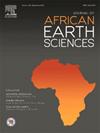Clinopyroxene geochemistry and zoning as a petrogenetic tool to assess the crystallization conditions of the alkaline Talzast Dome (Middle Atlas, Morocco)
IF 2.2
4区 地球科学
Q2 GEOSCIENCES, MULTIDISCIPLINARY
引用次数: 0
Abstract
Located in the SW border of the Middle Atlas Causse, the Talzast Dome comprises highly SiO2-undersaturated nephelinites with singular features. This Miocene volcanic dome displays a zoned structure whose rock types change from the periphery towards the centre regarding texture and mineralogical composition. The external zone of the dome is made of ankaratrite (a melanocratic variety of olivine nephelinite displaying a porphyritic microlitic texture), the intermediate zone is composed of fasinite (feldspar-free medium-grained variety of melteigite), and the central zone consists of coarse-grained to pegmatitic ijolite named talzastites in honour of the Talzast area. Such coarse-grained and pegmatitic ijolite were previously unknown in the entire Middle Atlas Miocene-Quaternary magmatic province.
The Talzast Dome nephelinites contain abundant clinopyroxene phenocrysts and microcrysts, with complex zoning patterns. Three distinct types of clinopyroxene were identified based on their zoning patterns: a) type 1 exhibits reverse zonation with low-Mg# rounded resorbed cores (Mg# = 66–79), surrounded by high-Mg clear rims (Mg# = 72–84); b) type 2 phenocrysts generally display normal zonation, with high-Mg cores (Mg# = 75–85) and low Mg rims (Mg# = 53–75); c) type 3 phenocrysts are euhedral and show no zonation pattern. The textural and compositional features of the studied clinopyroxenes suggest the presence of antecrysts and autocrysts, reflecting complex magmatic processes.
Thermobarometric Clinopyroxene-liquid and Clinopyroxene-only calculations for the studied rocks revealed a wide P-T range, varying from 0.04 to 14.73 kbar (±1.5 kbar) and 1008 to 1233 °C (±52–60 °C), respectively. Furthermore, the data indicates the existence of three main magma storage zones at depth: a) a deep magma reservoir (≃ 27 km); b) an intermediate magma reservoir (≃10 km); and c) a shallow magma reservoir (≃ 2 km). Whole-rock geochemistry suggests that the Talzast Dome rocks resulted from magmatic differentiation processes that occurred in a shallow magmatic reservoir, as indicated by the detailed mineral-scale analysis of the clinopyroxene crystals. Ankaratrite represent the least differentiated rock, followed by fasinites. Talzastites are the most differentiated products of this dome. The genesis of pegmatitic rock-types imply the influence of volatile agents, concentrated after the bulk of fractional crystallization had occurred.
斜辉石地球化学及分带对碱性Talzast巨丘结晶条件的影响
Talzast Dome位于中阿特拉斯山脉的西南边界,由具有独特特征的高sio2不饱和钠辉石组成。该中新世火山穹丘呈分带结构,岩石类型从外围到中心,在结构和矿物组成上发生变化。圆顶的外部区域由无晶石(一种黑色的橄榄云母岩,呈斑状微晶状结构)组成,中间区域由fasinite(一种无长石的中粒熔辉岩)组成,中央区域由粗粒至伟晶岩组成,命名为Talzast地区的talzastiites。在整个中阿特拉斯中新世-第四纪岩浆省中,这种粗粒伟晶岩是前所未有的。塔尔扎斯特穹窿云母岩含有丰富的斜辉石斑晶和微晶,具有复杂的分带模式。三种不同类型的斜辉石的分带模式:a) 1型斜辉石表现出相反的分带,低Mg#的圆形再吸收岩心(Mg# = 66 ~ 79)被高Mg#的透明岩心包围(Mg# = 72 ~ 84);b) 2型斑晶一般呈正常分带,高镁核(Mg# = 75 ~ 85)和低镁环(Mg# = 53 ~ 75);C) 3型斑晶为自形,无分带。斜辉石的结构和成分特征表明,斜辉石中存在反晶和自晶,反映了复杂的岩浆作用。对所研究岩石进行液态斜辉石和纯斜辉石的热气压计算显示,P-T范围很宽,分别为0.04 ~ 14.73 kbar(±1.5 kbar)和1008 ~ 1233°C(±52 ~ 60°C)。此外,数据表明在深度处存在三个主要的岩浆储存带:a)深层岩浆库(≃27 km);B)中间岩浆库(≃10 km);c)浅层岩浆库(≃2 km)。对斜辉石晶体的详细矿物尺度分析表明,塔尔扎斯特圆顶岩石是岩浆分异作用的结果,岩浆分异作用发生在浅层岩浆储层中。安卡拉岩是分异最小的岩石,其次是法长岩。塔尔萨石是这个穹顶最与众不同的产物。伟晶岩类型的成因暗示了挥发剂的影响,这些挥发剂在分馏结晶发生后集中。
本文章由计算机程序翻译,如有差异,请以英文原文为准。
求助全文
约1分钟内获得全文
求助全文
来源期刊

Journal of African Earth Sciences
地学-地球科学综合
CiteScore
4.70
自引率
4.30%
发文量
240
审稿时长
12 months
期刊介绍:
The Journal of African Earth Sciences sees itself as the prime geological journal for all aspects of the Earth Sciences about the African plate. Papers dealing with peripheral areas are welcome if they demonstrate a tight link with Africa.
The Journal publishes high quality, peer-reviewed scientific papers. It is devoted primarily to research papers but short communications relating to new developments of broad interest, reviews and book reviews will also be considered. Papers must have international appeal and should present work of more regional than local significance and dealing with well identified and justified scientific questions. Specialised technical papers, analytical or exploration reports must be avoided. Papers on applied geology should preferably be linked to such core disciplines and must be addressed to a more general geoscientific audience.
 求助内容:
求助内容: 应助结果提醒方式:
应助结果提醒方式:


